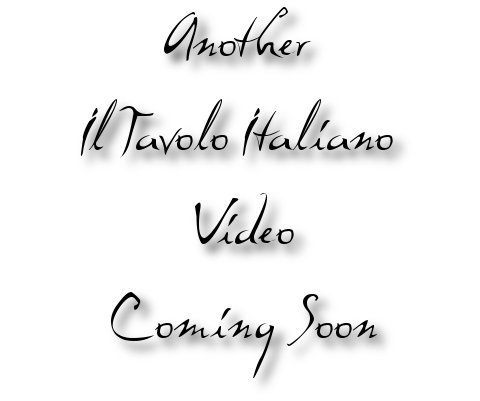Enhanced Beginner's Italian Level 1 - Lesson # 2
Subject pronouns, essere (to be), avere (to have) & vocabulary
After this class you should;understand verb conjugation and know the main personal subject pronouns.
be able to conjugate and use the verbs essere (to be) and avere (to have).
be able to use vocabulary such as please, thank you, you are welcome, I am and more.
GrammarTo Conjugate – “…To inflect (a verb) in its forms for distinctions such as number, person, voice, mood, and tense.”The definition of conjugate taken from thefreedictionary.com
| |||||||||||||||||||||||||||||||||||||||||||||
|
|
|||||||||||||||||||||||||||||||||||||||||||||
|
|
|||||||||||||||||||||||||||||||||||||||||||||
| |||||||||||||||||||||||||||||||||||||||||||||
|
|
|||||||||||||||||||||||||||||||||||||||||||||
|
|
|||||||||||||||||||||||||||||||||||||||||||||
|
|
|||||||||||||||||||||||||||||||||||||||||||||
 printable crossword printable crossword
|
|||||||||||||||||||||||||||||||||||||||||||||
Comprehension
| |||||||||||||||||||||||||||||||||||||||||||||

|
|
||||||||||||||||||||||||||||||||||||||||||||
|
|
|||||||||||||||||||||||||||||||||||||||||||||
 printable comprehension crossword printable comprehension crossword
|
|||||||||||||||||||||||||||||||||||||||||||||
|
Useful Italian question; Chi ... ? Who ... ? |
|||||||||||||||||||||||||||||||||||||||||||||
Class DialogUsing only the vocabulary we have learned so far, learn how to say everything below in Italian (except what is in " "), print out and bring the printable form of this dialog and be prepared to read the dialog below as person 1 or person 2 in class.Person #1 - Good evening Sir (or Miss), Person #2 - Good evening Sir (or Miss), how are you? Person #1 - I am fine, thank you, and you? How are you? Person #2 - I am very well, thank you. My name is _____________. What is your name? Person #1 - I am ____________. Pleased to meet you. Person #2 - Pleased to meet you. Person #1 - Sir (or Miss) I would like you to meet __________. Person #2 - Pleased to meet you. Person #3 - I am sorry, what is your name please? Person #2 - My name is _________. Person #3 - Thank you. Person #2 - You are welcome. Person #3 - How do you say "good night" in Italian? Person #2 - Good Night. Person #3 - Good night Sir (or Miss) Person #2 - Good night Sir (or Miss) Person #1 - Good night Sir (or Miss) | |||||||||||||||||||||||||||||||||||||||||||||
You can learn more about subject pronouns, essere and avere on these pages of the following books.
24 - 28, 42 - 49, 61 - 66 of the book "English Grammar for Students of Italian" by Sergio Adorni and Karen Primorac, copyright 1995.
12 - 14, 43 - 45 (page #'s may vary as I have an older edition) of "Ciao" by Carla Federici & Carla Larese Riga, copyright 1986.
55 - 57 of the book "Complete Italian Grammar" by Marcel Dansesi, copyright 1976.
49 - 51 of the book "Italian Grammar Drills" by Paola Nanni-Tate, copyright 2007.
1, 50 & 51 of the book "Italian Verb Drills" (Third Edition) by Paola Nanni-Tate, copyright 2011.
3 - 13 of the book "Italian Pronouns & Prepositions" by Daniela Gobetti, copyright 2006.
If you do not own these books, don't worry, it is not mandatory that you do unless you were instructed to buy them at the beginning of the class. However, they can be very useful in a lot of ways and if you would like to know more about these books and where to buy them, simply go to our online bookstore or quicker yet, just click on the appropriate book below.
Did you know? - A bit of Italian Trivia
The early version of the thermometer was an Italian invention. “Before there was the thermometer, there was the earlier and closely related thermoscope, best described as a thermometer without a scale. A thermoscope only showed the differences in temperatures, for example, it could show something was getting hotter. However, the thermoscope did not measure all the data that a thermometer could, for example an exact temperature in degrees.Early History
Several inventors invented a version of the thermoscope at the same time. In 1593, Galileo Galilei invented a rudimentary water thermoscope, which for the first time, allowed temperature variations to be measured. Today, Galileo's inventioni is called the Galileo Thermometer, even though by definition it was really a thermoscope. It was a container filled with bulbs of varying mass, each with a temperature marking, the buoyancy of water changes with temperature, some of the bulbs sink while others float, the lowest bulb indicated what temperature it was.
In 1612, the Italian inventor Santorio Santorio became the first inventor to put a numerical scale on his thermoscope. It was perhaps the first crude clinical thermometer, as it was designed to be place in a patient's mouth for temperature taking. Both Galilei's and Santorio's instruments were not very accurate. In 1654, the first enclosed liquid-in-a-glass thermometer was invented by the Grand Duke of Tuscany, Ferdinand II. The Duke used alcohol as his liquid. However, it was still inaccurate and used no standardized scale...." -
Source - about.com
http://inventors.about.com/od/tstartinventions/a/History-Of-The-Thermometer.htm
Have you heard? - Some good Italian Music
Coming from a little more of a smooth jazz perspective, Sergio Cammariere definitely has a talent for creating songs perfect for that romantic night. Shouldn't surprise us though. After all, on aspect many of us love about the Italian culture is passion! I hope you enjoy!|
great songs are available on ---> |
blog comments powered by Disqus

